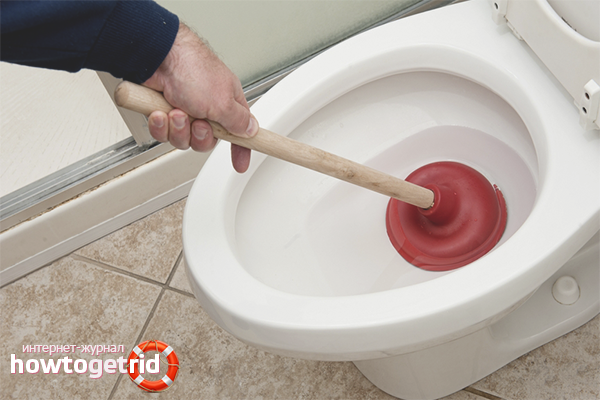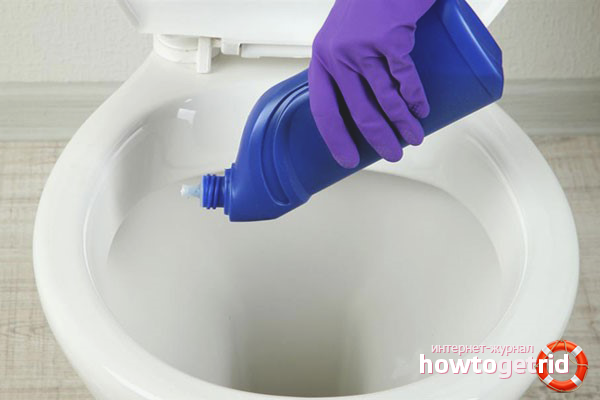A clogged toilet is a disaster for a modern person. And given the speed of response of emergency utilities, it is also a headache. In order not to rattle our nerves with inadequate plumbers (yes, they are still alive as a nation), let's try to solve the problem on our own.
On the vastness of the mighty Internet, there are a variety of recommendations on how to remove a blockage in the toilet. Almost all of them have worked well, but sometimes some refinements and additions are required. In order not to grieve in a stinking puddle near a white man's friend, let's figure it out.
All cleaning methods fall into two categories: chemistry and mechanics. The former help only with minor local blockages. The second is heavy artillery. It is used when chemicals have failed. You can use mechanics right away, but they are dirty. Therefore, the choice is yours.
Chemical methods
Water. No, not just water from a tank. And hot, 75-80 degrees. You can heat it to boiling water, but only if you are sure of the strength of the toilet. Because sometimes it just bursts into two halves. Then a warm, smelly mess will spill around. It is the hot one that is the safest. You will need a lot of it, at least 10 liters. Raise the container to a height of about 50 cm and pour out the water with an even, quick movement so that it falls at an angle of 90 °.
We do not pour on ourselves! On those around you too (and your family will certainly be ready to admire your attempts). We take precautions. A weak fatty blockage will break through and go down the drain.
Soda. The most common baking soda in an orange and white pack. We pour it into the toilet from the heart, not sparing. Straight into the water and wait. If the blockage is caused by organic matter or plaque, the alkaline environment will dissolve it. If the blockage is mechanical, then soda will not help.
There are recommendations to add vinegar along with soda. What for? Even if all chemistry lessons were missed at school, you should still know the truism: acid always neutralizes alkali! And if you pour vinegar into the toilet after pouring soda, you get a long "zilch" and no effect.
All the same, they were going to clean the toilet, and not make a sweet fizzy!
Advice. The recipe for removing blockages with carbonated drinks is based on the same effect. But whatever is not good. Only Pepsi or Cola are suitable. If you accidentally have a bottle at hand, feel free to pour it into your white friend. True, this will not eliminate a serious blockage.
Alkali. Alkali-based clogging cleaners are still popular. We will not give the names here, so as not to advertise. But some are aggressive enough to deal with severe organic clogging. Here is just a dirty method of use.
You will have to scoop out as much liquid as possible from the toilet. If possible, then all visible is desirable. Then the product is poured and left for at least two hours. After this time, the toilet is flushed with plenty of water.
It is very important to use at least 3, and preferably 5, buckets of liquid for flushing. After all, if you do not wash off the lye with the softened blockage properly, then later this whole mixture will simply petrify. After that, you will have to dismantle the plumbing and change the pipes. This stone can no longer be removed by anything.
Alkali will not help if the blockage is caused by the ingress of inorganic substances - polyethylene, plastic, synthetics.
The only one for whom this method may not work is the owners of plastic pipes. They will not dissolve from alkali, but they can completely warp them. Therefore, try alternative methods to avoid repairs. And be careful, because the product is remarkably corrosive to the skin of the hands and mucous membranes of the eyes and respiratory tract. They poured it quickly, closed the lid tightly and returned only after 2 hours.
Advice. One bottle will not be enough to fill the entire toilet siphon. It will take at least three pieces to get the desired effect.
Acid. It helps well in the fight against inorganic blockages. If your family likes to throw pads, diapers or bags into the toilet, then feel free to pour acid into the toilet. By the way, synthetic rags dissolve well too.
After 40-45 minutes you will have to pour some water. The toilet must be thoroughly rinsed so that the remains of the blockage with acid go down the drain. Then it is advisable to slap on the neck of the household so that they do not throw any rubbish into the toilet.
Advice. The acid will dissolve hair, food, cleaning vegetables for a very long time. It will not cope with fat at all. Use it only when you are sure exactly what caused the blockage. And don't forget about safety!
Mechanical methods
Ventuz. Good old, familiar plunger. We take the one that is larger in diameter than the toilet drain hole, press it firmly. And we begin such familiar reciprocating movements. Fluctuations of the liquid inside the bowl destroy the blockage, the whole byaka flows out.

Modern plungers look slightly different than everyone is used to seeing. They have a piston and work like a pump, which makes them much more efficient. Even his solid appearance alone will already elevate you in the eyes of the household, and if you cope with the blockage yourself, then honor and praise you!
Advice. The plunger works better if its lower part is in a liquid medium. This creates an additional vacuum.
Bottle. An ordinary plastic bottle has a similar effect. Suitable for a volume of 1.5 or 2 liters, depending on the diameter of the drain hole. The very bottom is cut off with a sharp knife and the lid is screwed tightly. Or a suitable handle is inserted into the neck, for example, from a mop. Then the resulting structure is inserted into the toilet from the bottom and the work of a true plumber begins. That is, they work like a regular plunger.
By the way, according to reviews, this method is very effective. Enough 30 seconds of furious efforts and your white friend after such blasphemy will not want to clog up for a long time.
By the way, completely ignore the giggles and chuckles of all the witnesses of your labor. They don't understand anything. But when all the rubbish leaves the toilet to the right place, then you can scoff at them with a proud look. Say, and you were laughing.
Advice. It does not matter at all what was in the bottle before its true purpose. Whichever one is at hand will come in handy. Just be sure to immediately take it to the trash. Fecal bacteria from its surface quickly end up in the air.
Cable. The plumbing line is a flexible hollow structure with a hook at one end and a handle at the other. It is carefully inserted into the toilet, then the handle is turned clockwise, while at the same time it is pushed inward with effort. The hook will break up the blockage or catch the culprit and pull it out.
Be sure to use heavy rubber gloves. This will reduce the risk of damage to the skin of the palms. By the way, the smell from the bowels of the toilet remains on your hands for up to two days and is practically not washed off by anything. Therefore, we work only with gloves.
It would be nice to prepare some kind of unnecessary container or a tight bag, a large rag or rags and a bottle of dishwashing liquid. When pulling the cable back out, dampen a cloth with liquid and wipe it off immediately. This will reduce stench and dirt. Then just throw the rags into the prepared bag. Send everything that is hooked there. And that is, the craftsmen - take out some muck and immediately try again to flush it back down the toilet.
Advice. It is convenient to work with a cable in a pair with someone. One will be problematic. Of course, if you are not a natural born plumber, whose cable works by itself from one movement of the eyebrows.
- Some "experts" advise pushing yeast into the toilet bowl, and more. And wait for a miracle. It will certainly happen. In the form of seething content through all sewer pipes and increasing the volume tenfold. And if the neighbors find out who did it, then all that remains is to advise you to run. With documents from the country. It's just that whoever has done this at least once has not survived. This is a local apocalypse.
- Other advisors recommend blowing into the toilet to clear the blockage. Preferably from a fire hose or similar aid. Hmm. There is still a bike among the people about one such "blower". He just worked as a driver on a fire truck. I came home for lunch and decided in one fell swoop ... Fortunately, I lived on the first floor. He pulled his sleeve through the window, inserted it into the toilet and blew. The blockage has broken through, yes. He took off. Together with the contents of the sewer. Fountains in toilets, bathrooms and sinks. Up to the fifth floor and in all apartments. The peasant had to move.
- Throwing dry ice into water in case of blockage is also recommended. Just what effect is expected? Steam clubbing with incredible toilet amber? So they will not remove the blockage. All these fumes will safely end up in your home. If you want a holiday - use ice for other purposes.
- Pour half a bottle of dishwashing detergent into a white friend. What happened next? Half a vial is only 250 ml of liquid. This amount will not even be able to overcome the water intake. And if it does overflow, how will it remove the blockage? Talk to him like a man? Like, let's go, come out. What nonsense! All dishwashing detergents are surfactant-based, i.e. superficial. They will not penetrate deep into the blockage.

- Before you start fighting any blockage, you need to determine where it is. It is quite possible that this is not your local problem, but the obstruction of the central sewerage system. Then it makes sense to call the emergency service after all.
- If possible, be sure to install a non-return valve at the outlet of your sewer system. It's a little expensive, but worth it. Because living on the lower floors, you risk seeing in your toilet or bathtub everything that the upper floors will drain when the central pipe is clogged. And with this device you can sleep peacefully.
- Don't have a plunger or a bottle at hand? An impromptu crush is fine. This is a thick layer of rag wrapped around a stick, carefully tied with a strong cord. The principle of operation is identical.
- By the way, it is not recommended to use a long cable on your own in the presence of a check valve. Since there is a chance of damaging it with inept actions.
- How to remove a blockage in the toilet? Using improvised means is very simple. And then you will not have to wait for a plumber for three days, and even pay for the work.
And yet - use the toilet for its intended purpose. Do not throw trash, food leftovers, or trash into it. Then this article will not be useful to you at all.



